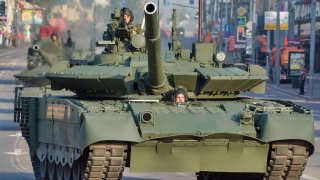Russia's T-80BVM Tank Is Just a Big 'Metal Coffin'
Summary and What You Need to Know: Russia has acknowledged the limitations of its T-80BVM tanks, which were designed during the Cold War. Despite recent upgrades, including "anti-drone" protection and enhanced firepower, the tanks have proven to be vulnerable on the battlefield, especially in Ukraine.
-As a result, they are being repurposed as self-propelled artillery, firing from safer, rear positions rather than engaging in frontline combat.
-The T-80's history of poor performance, notably in Chechnya, and the significant losses in Ukraine underscore its shortcomings, making it more of a "metal coffin" for its crew than a viable modern battle tank.
The T-80BVM is a Metal Coffin, and Russia is Finally Acknowledging as Much
Russia continues to tout the latest enhancements of its military platforms, and that has included the T-80BVM main battle tank. Last month, the military-industrial conglomerate Rostec announced the latest batch of the Cold War-era designed MBTs were receiving "anti-drone" protection – essentially a special mesh screen and nets that were meant to protect the engine and transmission compartments from a first-person-view unmanned aerial systems (UAS) as well as from shaped charges and even guided missiles.
As previously reported, the effectiveness of the "anti-drone protection" should be taken with a huge grain of salt, but now Rostec has announced it is looking to further boost the T-80BVM's firepower.
"The tank continues to be modernized to reflect the experience of its combat use during the special military operation. The work is focused on increasing its firepower, protection, mobility and responsiveness to commands," Rostec announced via a statement on the Telegram social messaging app, according to a report from state media outlet Tass.
From the statement, it would seem that new improvements are being made to the vehicles, but that might not be the case. Instead, Russia appears to be changing its doctrine of how the tanks are employed in the ongoing fighting in Ukraine.
"As part of the special military operation, tanks are regularly used as self-propelled artillery units for firing from sheltered positions, the company said on Telegram. The experience of using tanks this way has reached extensive proportions as the armored vehicles effectively fire fragmentation projectiles at enemy infantry and their positions," the Tass report added.
In other words, instead of rolling the tanks forward to enemy positions, where the MBTs would be vulnerable to enemy fire from man-portable anti-tank launchers, FPV drones and notably enemy armor, the maker of the tank is suggesting these be used safely behind the lines.
The T-80 was the last true MBT developed by the Soviet Union, and though it was initially designed for speed where it was thought it could break through enemy lines and serve at the forefront of an invasion.
It didn't live up to its expectations. Instead, it proved to be a quick-moving metal coffin for those inside.
When it was used in the First Chechen War (1994-96), the tanks proved especially vulnerable to man-portable anti-tank weapons, and the losses were so great that it was even sidelined during the Second Chechen War in 1999 and then again in 2008 Russo-Georgian conflict.

The T-80 probably wouldn't have seen service in the ongoing conflict in Ukraine had the Kremlin's forces made it to Kyiv in the planned three days. But as its tank losses mounted, hundreds were pulled from storage, and provided with the upgrades but in reality, it remains a flawed MBT that shouldn't be sent into frontline combat.
Harrison Kass previously wrote for The National Interest that "The Russians have already lost roughly 700 T-80 tanks since the war began. The T-80's survivability problems are a common theme."
It now appears that the Kremlin has realized as much, and the T-80BVMs will serve as self-propelled artillery. It is hardly an effective use for the MBTs, but the alternative option is simply worse.
Author Experience and Expertise: Peter Suciu
Peter Suciu is a Michigan-based writer. He has contributed to more than four dozen magazines, newspapers, and websites with over 3,200 published pieces over a twenty-year career in journalism. He regularly writes about military hardware, firearms history, cybersecurity, politics, and international affairs. Peter is also a Contributing Writer for Forbes and Clearance Jobs. You can follow him on Twitter: @PeterSuciu. You can email the author: [email protected].
Image Credit: Shutterstock.


